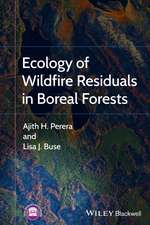Use of Landscape Sciences for the Assessment of Environmental Security: NATO Science for Peace and Security Series C: Environmental Security
Editat de Irene Petrosillo, Felix Müller, K. Bruce Jones, Giovanni Zurlini, Kinga Krauze, Sergey Victorov, Bai-Lian Li, William G. Kepneren Limba Engleză Paperback – 2 oct 2007
| Toate formatele și edițiile | Preț | Express |
|---|---|---|
| Paperback (1) | 1226.90 lei 6-8 săpt. | |
| SPRINGER NETHERLANDS – 2 oct 2007 | 1226.90 lei 6-8 săpt. | |
| Hardback (1) | 1233.20 lei 6-8 săpt. | |
| SPRINGER NETHERLANDS – 2 oct 2007 | 1233.20 lei 6-8 săpt. |
Din seria NATO Science for Peace and Security Series C: Environmental Security
- 18%
 Preț: 1106.00 lei
Preț: 1106.00 lei - 15%
 Preț: 659.70 lei
Preț: 659.70 lei - 18%
 Preț: 999.60 lei
Preț: 999.60 lei - 18%
 Preț: 1221.07 lei
Preț: 1221.07 lei - 18%
 Preț: 1220.75 lei
Preț: 1220.75 lei - 18%
 Preț: 940.39 lei
Preț: 940.39 lei - 18%
 Preț: 1216.78 lei
Preț: 1216.78 lei - 18%
 Preț: 1232.71 lei
Preț: 1232.71 lei - 18%
 Preț: 1818.02 lei
Preț: 1818.02 lei - 18%
 Preț: 1833.95 lei
Preț: 1833.95 lei - 18%
 Preț: 1231.47 lei
Preț: 1231.47 lei - 18%
 Preț: 942.44 lei
Preț: 942.44 lei - 18%
 Preț: 1218.06 lei
Preț: 1218.06 lei - 18%
 Preț: 1383.00 lei
Preț: 1383.00 lei - 15%
 Preț: 664.29 lei
Preț: 664.29 lei - 18%
 Preț: 1220.88 lei
Preț: 1220.88 lei - 24%
 Preț: 1040.03 lei
Preț: 1040.03 lei - 18%
 Preț: 1222.80 lei
Preț: 1222.80 lei - 18%
 Preț: 1220.75 lei
Preț: 1220.75 lei - 18%
 Preț: 1224.85 lei
Preț: 1224.85 lei - 18%
 Preț: 1224.85 lei
Preț: 1224.85 lei - 18%
 Preț: 1224.68 lei
Preț: 1224.68 lei - 18%
 Preț: 963.15 lei
Preț: 963.15 lei - 18%
 Preț: 1229.10 lei
Preț: 1229.10 lei - 18%
 Preț: 1222.49 lei
Preț: 1222.49 lei - 18%
 Preț: 1223.74 lei
Preț: 1223.74 lei - 18%
 Preț: 1213.65 lei
Preț: 1213.65 lei - 18%
 Preț: 956.33 lei
Preț: 956.33 lei - 18%
 Preț: 1235.43 lei
Preț: 1235.43 lei - 18%
 Preț: 940.39 lei
Preț: 940.39 lei - 18%
 Preț: 1210.63 lei
Preț: 1210.63 lei - 18%
 Preț: 1219.63 lei
Preț: 1219.63 lei - 18%
 Preț: 1225.48 lei
Preț: 1225.48 lei - 18%
 Preț: 1228.75 lei
Preț: 1228.75 lei - 18%
 Preț: 1228.62 lei
Preț: 1228.62 lei - 18%
 Preț: 1222.94 lei
Preț: 1222.94 lei - 18%
 Preț: 962.98 lei
Preț: 962.98 lei - 18%
 Preț: 1218.06 lei
Preț: 1218.06 lei - 15%
 Preț: 643.99 lei
Preț: 643.99 lei - 18%
 Preț: 1220.12 lei
Preț: 1220.12 lei - 18%
 Preț: 1233.52 lei
Preț: 1233.52 lei - 18%
 Preț: 946.24 lei
Preț: 946.24 lei - 18%
 Preț: 1218.21 lei
Preț: 1218.21 lei - 18%
 Preț: 953.65 lei
Preț: 953.65 lei
Preț: 1226.90 lei
Preț vechi: 1496.22 lei
-18% Nou
Puncte Express: 1840
Preț estimativ în valută:
234.77€ • 255.81$ • 197.83£
234.77€ • 255.81$ • 197.83£
Carte tipărită la comandă
Livrare economică 23 aprilie-07 mai
Preluare comenzi: 021 569.72.76
Specificații
ISBN-13: 9781402065897
ISBN-10: 1402065892
Pagini: 509
Ilustrații: XII, 497 p.
Dimensiuni: 155 x 235 x 33 mm
Greutate: 0.71 kg
Ediția:2008
Editura: SPRINGER NETHERLANDS
Colecția Springer
Seria NATO Science for Peace and Security Series C: Environmental Security
Locul publicării:Dordrecht, Netherlands
ISBN-10: 1402065892
Pagini: 509
Ilustrații: XII, 497 p.
Dimensiuni: 155 x 235 x 33 mm
Greutate: 0.71 kg
Ediția:2008
Editura: SPRINGER NETHERLANDS
Colecția Springer
Seria NATO Science for Peace and Security Series C: Environmental Security
Locul publicării:Dordrecht, Netherlands
Public țintă
ResearchCuprins
– Environmental Security and Landscape Ecology.- Contributions of Landscape Sciences to the Development of Environmental Security.- Landscape Ecology and Environmental Security: basic concepts and regional applications for the Medit.- Landscape management for environmental security: some perspectives of adaptive management approaches.- The policy framework GMES as a guideline for the integration of environmental security research and landscape sciences.- – Landscape Science Methodologies to Assess Environmental Security.- Investigating landscape patterns in protected areas using aster images.- Quantifying and Qualifying Urban Green by Integrating Remote Sensing, GIS, and Social Science Method.- Allometric scaling as an indicator of ecosystem state: a new approach.- – Landscape Indicators and Landscape Change Detection.- Deriving the spatial traits of organized land structures.- Landscape monitoring as a tool in improving environmental security.- Landscapes of the natural park “Vepssky Forest”.- Multi-temporal coastal zone landscape change detection using remote sensing imagery and in situ data.- Landscape character as a framework for the assessment of environmental change.- – Integrated Studies of Catchments and Basins.- An ecohydrological approach for the protection and enhancement of ecosystem services.- Environmental quality and landscape-hazard assessment in the Yantra River Basin, Bulgaria.- The influence of catchment land cover on phosphorus balance for large freshwater systems.- The use of scenario analysis to assess future landscape change on watershed condition in the pacific northwest (USA).- Cross-European landscape analyses: illustrative examples using existing spatial data.- – Assessments of Human-Environmental Systems in Landscapes.-Demographic impacts on landscape change – a conceptual view of global demographic trends.- Land use impacts of demographic change – lessons from Eastern German urban regions.- The consequences of demographic change in Rhineland-Palatinate: scenarios of landscape consumption for settlement and transportation areas.- Landscape, demographic developments, biodiversity, and sustainable land use strategy: a case study on karaburun peninsula izmir, turkey.- Indication of the State of the Environment with GIS and People: a Case Study and planning tool for mulfingen, a municipality in South Germany.- Environmental security as related to scale mismatches of disturbance patterns in a panarchy of social-ecological landscapes.- Fostering ecosystem services’ security by both objective and subjective analyses: the case of a natural protected area in Southern Italy.- Environmental assessing of reindeer herding in changing landscapes on different scales.- – Environmental Applications of Landscape Ecological Methods – Impact Assessments.- The contribution of quality assessment of eroded agricultural soil on hilly-undulating landscapes to sustainable community development.- Nuclear safety and its impact on the level of environmental security in Ukraine.- Environmental impact assessment as a tool for environmental restoration: the case study of Cop?a-Mic? area, romania.- Landscape approaches to assess environmental security: summary, conclusions, and recommendations.
Caracteristici
Compiles the most up-to-date landscape approaches and tools useful for the assessment of environmental security, a worldwide issue of social, economic, environmental and institutional importance Contributes to a new perspective of the environmental security combining subjective and objective assessment of environmental risk in the context of social-ecological landscapes Identifies the actual main driving forces (demography, land-use, industry) that can threat environmental security at local, national and international scale Introduces the new concept of "securability"












